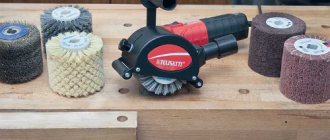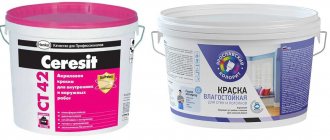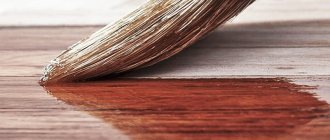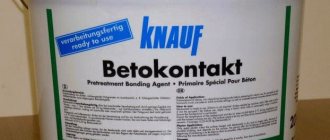Drying oil for wood is a film-forming transparent liquid made from natural or artificial components. It can be used for priming and as an additive for more complex mixtures.
What is drying oil used for? It is used separately and as a material for surface treatment when working on wood. Why treat the surface? Wood itself is not very strong and is not very durable. Drying oil is a component that allows you to protect wooden products and surfaces. In addition, it allows you to reduce the consumption rates of a decorative coating, such as varnish, or a coloring agent - it will not be additionally absorbed into wood already impregnated with oil.
How to coat plywood with drying oil on both sides? What are the nuances?
How to coat plywood with drying oil on both sides at once?
What will be the consumption of drying oil per 1 m2 of plywood? Is 1 coat enough coverage? Typically, plywood is impregnated with drying oil if there is a need to increase the moisture resistance of the material.
Of course, you can saturate the plywood on both sides; it won’t make things worse, but you have to be prepared for the fact that it will take days, and possibly weeks, to completely dry.
To coat at one time, the plywood must be in a vertical position so that it is possible to turn the sheet over, in other words, lean the plywood against the wall and thus work with the sheet.
Plywood is different in grade, thickness and texture, which is why the consumption of drying oil is different, on average, from 80 to 100 grams of drying oil are used per square meter.
One layer is not enough, perhaps three layers will not be enough, the reason was described above (texture, grade, thickness), the plywood is impregnated with drying oil until it is saturated to the adhesive layer.
For this purpose, buy natural drying oil, you can dilute it a little with white spirit,
but better than natural and without solvent.
Before applying drying oil to the surface of plywood, it (the drying oil) is heated in a water bath, the drying oil should be hot, but do not “overdo it” with the temperature, hot is closer to warm, that’s right.
Next, clean the plywood from dust and dirt.
Using a brush or roller, apply drying oil to both sides of the plywood, do not forget about the ends.
After this, we dry the plywood with an industrial hair dryer.
Next is a new layer of drying oil and so on until the plywood stops “accepting” drying oil, in other words, the absorption process stops.
More questions on your topic:
- What is the essence of the technology of coating plywood with drying oil?
- How can you remove drying oil from plywood?
- How to wash off drying oil from plywood?
- How to accurately calculate paint consumption per 1 m2 in two layers?
- What are the advantages of the Solex carburetor? Is it worth installing a carburetor?
- How to calculate how many sq. m. m. ceramics. tiles or plastic panels?
- How much water-based paint is consumed per 100 square meters?
- Consumption standards for building materials, where can I look?
- What is the consumption of cement and sand per 1 cubic meter? stone plinth (rubble)?
- How to get rid of drying oil smell on a wooden door?
Paint consumption per square meter, per 1m2
This article provides information on paint consumption per square meter, as well as the conditions on which paint consumption depends.
We will touch on types of paint, such as: oil-based, water-dispersion and water-based, facade. We’ll also talk about the consumption of enamels, in particular about PF-115. Let's analyze the consumption of drying oil. Try calculating your consumption in the extended version of the paint consumption calculator, you can also read the article about the consumption of plaster materials and calculate the consumption of plaster for walls in the calculator.
Oil paint consumption
Oil paints use drying oil as a binder, which polymerizes after application to the surface. Consumption can vary from 140 grams per meter to 250. Let's look at it in more detail: For a flat surface, we will need about 150 grams per meter, that is, with a kilogram can we can paint about 6.5 meters. For a rough surface, more will be required, approximately 160 g/m. Colored paint per 1m2 will require 130-140 grams.
Consumption of enamel pf-115
Consumption of acrylic-based water-dispersion paint
Acrylic-based water-dispersion paints are used both indoors and when working on facades. They have a matte appearance and are tinted with color pastes. They provide a large palette of colors that do not fade in the sun. The manufacturer indicates consumption up to 8 m2 per 1 liter, but in practice the covering capacity is usually 115 g/m2 (i.e. 1 liter per 6-7 m2). The fact is that the manufacturer indicates the given consumption rates in a thin layer, on a smooth surface, under ideal conditions. In practice, much depends on the absorbency and surface roughness. The method of application also matters. For example, when using a spray gun, less paint will be used than when working with a roller. Again, a roller is more economical than a brush. Be aware that you will need 5-15% more paint than indicated on the package. Apply acrylic paints in 2-3 layers on a clean, dry base. Moreover, a high-quality composition will cover the color of the base in 2 layers, while a cheaper version will require 3 layers. Thus, cheap paint can actually cost more.
The color can last on concrete without visible changes for up to 5 years, then it darkens and after 2-3 years it can begin to peel off. If such paint is applied to plaster, cement, etc. , then priming can be done with it, diluted with water up to 10%. Then a layer of undiluted paint is applied.
Consumption of water-based paint
Water-based paints are used for finishing ceilings and any other surfaces, except those that were previously painted with glossy paint. When calculating paint consumption, you need to focus on the consumption per square meter specified by the manufacturer. On average it is 1 liter per 7-11 m2. For some water-based paints, one liter is enough for 14-18 m2 in one layer. But the indicated consumption may not coincide with the actual one; the absorbency of the surface should be taken into account. To reduce paint consumption and increase service life, it is recommended to treat the surface with a hardening primer. Do not apply water-based paint in a thick layer. Most often, 2-3 layers are made, each subsequent one is applied after the previous one has dried, after 1.5-2 hours. Paints based on butadiene styrene are highly resistant to moisture, but may turn yellow when exposed to light.
Facade paint consumption per 1m2
Almost all types of paints can be used as façade paint, so it is concluded that a specific type has its own consumption. Approximate consumption values are from 160 to 250 grams per square meter, while the consumption of white paint is always greater than other colors. Painting the facade will protect it well and preserve it, so the work should be done carefully and not try to save money.
Drying oil consumption per 1m2
Drying oil consumption ranges from 100 to 130 grams per square meter. By pre-coating a wooden surface with drying oil, you can save paint by 10-15%
The concept of “paint hiding power”
The greater the hiding power, the better the new paint covers the color of the old one, thus, the better the hiding power, the more economical the use. The best indicator is 20-40 g/1m2 of surface.
What is drying oil needed for: what does it do and how to use it correctly
Wood is now one of the most fashionable and popular construction and finishing materials due to its two main characteristics: environmental friendliness and aesthetics.
But at the same time, wood is not highly durable and durable compared to other modern materials. Natural wood requires special processing technology and additional protection; for this purpose, various impregnations, mastics, etc. are used.
Decorative coating with drying oil
Drying oil, almost forgotten in recent years due to the abundance of new products from foreign manufacturers in this category, is again in increasing demand - the effect is almost the same, but the price is much more affordable.
Why is drying oil needed and how to use it correctly when finishing a house or other building (for example, a gazebo or bathhouse) made of wood?
Manufacturers
Drying oil "Oxol" is a sought-after and popular finishing material, so today many brands are engaged in its production:
- releases this product for sale in a completely ready-to-use form. Drying oil is sold in containers weighing from 0.4 to 8 kg in one container. The composition dries quickly, significantly reduces paint consumption and does the job of a primer at the same time.
- Yamshchik LLC manufactures and directly sells this impregnating composition, which belongs to the PV category. It is sold in containers with a capacity of 0.8 to 20 kg. This product fully complies with the requirements of SanPiN and is manufactured in strict accordance with GOST.
- Isolate brand drying oil is considered one of the highest quality. Manufactured in accordance with accepted standards. Sold in containers with a capacity from 0.5 to 200 liters. The disadvantage of this company is that it produces drying oil of this type only to order and in wholesale quantities.
- VESTA-COLOR LLC produces and sells drying oil of this type wholesale and retail. The products of this brand are distinguished by high quality, affordable cost and high technical characteristics.
- PA "CHIMTEK" has been manufacturing and selling these products of the highest quality for more than 20 years. Drying oil "Oksol" produced by him always has excellent technical characteristics and an affordable price. It is sold in various types of containers, which allows each customer to purchase the most suitable packaging.
Drying oil "Oxol" produced by all these brands has proven in practice its high efficiency and excellent quality, therefore, when purchasing such a product, it is recommended to first pay attention to these manufacturers.
What is drying oil
Drying oil is a traditional paint and varnish material, widely used in construction and painting work several decades ago.
The basis of the product is any vegetable oil - sunflower, linseed, rapeseed or soybean, plus additional substances that form a waterproof film on the surface of the wood, protecting it from the formation of mold, mildew, rot and the effects of parasitic insects.
Under the Soviet Union, this was almost the only means used to process wooden products and buildings. He has his ardent admirers to this day.
Using drying oil for wooden walls
Drying oil helps reduce paint consumption, which is why it is often applied to wood not only as a protective layer, but also as a primer for painting. How to do this correctly?
Everything is extremely simple. Shake the bottle of product, or pour it into a large container and stir.
Drying oil is used to dilute oil paints
There is no need to prepare the walls in any special way - drying oil is not a varnish, after applying this product, small wood fibers will not rise up, forming small spines.
No sanding is required after complete drying.
Using a wide brush, apply drying oil like a regular primer, without skimping, but also not in such a way that it drips off - you will only extend the drying time; the performance characteristics of the wood will not improve from excess drying oil.
Why else do you need drying oil for wood? With its help, you can give the wood a certain shade, especially if you coat it with an additional varnish, not a transparent one, but a tinting varnish.
You can also add it to thick colored paint - it will not lose its qualities, and you will save on material consumption.
Using drying oil for the floor
Many people are interested in why drying oil is needed for the floor and whether it is needed at all. A primer coating for wood floors is necessary in any case. But what to choose – drying oil or another product is everyone’s personal choice.
Drying oil is the cheapest, but it has its own smell and is not enough to protect the wood well from moisture and abrasion.
It is worth noting that floors coated with drying oil must dry for several days before applying the next layer.
So, if you don’t have time, it’s better not to save money and look for another primer for a wooden floor.
Additional Information
Drying oil can be used for priming not only wooden walls, but also plastered ones. It is also often used as an anti-corrosion coating for metals.
It is important to choose the right type of product. A modern manufacturer produces drying oil of three varieties, different in composition and properties:
Natural drying oil. It consists of 95% vegetable oil, and only 5% of drier, a special additive that accelerates the drying of the treated surface.
It is unprofitable to use it for treating external surfaces due to high financial costs, while this type does not provide 100% protection against fungus and insects.
Natural drying oil is used to dilute oil paints and prime wooden surfaces before painting or varnishing.
Oxol. It consists of 55% natural oil component, 40% solvent, white spirit, and 5% drier. The scope and properties of this type of drying oil are the same as natural ones, only it dries faster and costs less.
It also does not provide 100% protection. Learn more about why Oxol drying oil is needed and what it consists of in the video:
Composite drying oil is made entirely from artificial chemical components, in particular petroleum-polymer resins, and has a pungent odor.
This type is strictly not recommended for treating interior spaces, otherwise you will be haunted by an unpleasant odor in the rooms for many months, not to mention possible intoxication when working with this product.
Drying oils based on alkyd resins are considered the best. They are not as greasy and expensive as natural drying oils, and not as toxic as composite ones. But, nevertheless, it is better to use them for finishing outdoor country buildings (porch, swing, gazebo, summer kitchen) and for the interior rooms of country houses and apartments.
Choose more modern, purified, reliable and safe formulations.
Cover the wood with drying oil
Drying oil is a good alternative to modern expensive means for impregnating and priming wooden surfaces.
But remember that some types can be toxic and are not suitable for use in residential areas.
If you need guaranteed protection from external factors, drying oil alone is not enough.
What is the difference between oxol and natural drying oil?
The table will clearly demonstrate the difference between the types of impregnation.
Table: differences between types of drying oil
| Natural | Oxol |
| Consists only of natural oils, no solvent, 3% drying agent. | Natural oils are present in an amount of at least 55%, the remaining volume is occupied by solvent (40%) and drier (5%). |
| Can be used to treat any surface. Excellent for expensive wood species. Used for external and internal work. | Not used for floors, category “B” product is used for both external and internal work, “PV” - only for internal use. |
| It is characterized by high cost. | The price is lower than its all-natural counterpart. |
| Does not have an unpleasant odor. | Due to the presence of solvent it has an odor. |
| Drying time depends on conditions, but should not exceed 24 hours. | Dries faster than natural. |
It is better to purchase the product in transparent packaging - if sediment is detected, it is better to refuse the purchase.
We determine the consumption and how long it takes for drying oil to dry on wood - correct application and comparison
Drying oil for wood is a film-forming transparent liquid made from natural or artificial components. It can be used for priming and as an additive for more complex mixtures.
What is drying oil used for? It is used separately and as a material for surface treatment when working on wood. Why treat the surface? Wood itself is not very strong and is not very durable. Drying oil is a component that allows you to protect wooden products and surfaces. In addition, it allows you to reduce the consumption rates of a decorative coating, such as varnish, or a coloring agent - it will not be additionally absorbed into wood already impregnated with oil.
Types of drying oil
All existing types of drying oil can be divided into the following categories:
- natural;
- semi-natural;
- combined;
- synthetic.
Natural types are made from oils of natural origin. Most often, the basis of natural impregnation is flax oil, although hemp or sunflower oil is also used. In natural solutions, a very small proportion of chemical components is acceptable. A desiccant is added to the composition - a substance that acts as a drying catalyst. Metal compounds - cobalt, manganese, lead, iron, etc. - are used as driers.
Natural impregnations are good, but quite expensive, and it is not practical to use them for treating building facades. In addition, they provide little protection against fungus, mold and insect pests. This type is used for diluting oil paints, as well as priming wood before painting it or applying varnish. Natural impregnations are also used as a basis for primer and putty mixtures. They are also used for processing wood in interior living spaces; natural drying oils are the least toxic, and in this respect they are better than other types. The drying time of such impregnation depends on the ambient temperature and at +20ºС it is approximately a day.
Semi-natural impregnations, or oxols, are also made from oil, most often sunflower. Their difference from natural ones is that they contain a large proportion of an organic solvent such as white spirit. Its amount in the solution can reach 40%. Oxols also contain about 5% driers.
Semi-natural drying oils are used in the same quality as natural ones, but more often for diluting paints or as a primer. They can be used to impregnate wooden materials in dry rooms. Oxols dry a little faster than natural solutions, while providing less drying oil consumption per 1 m2. In addition, they have lower manufacturing costs. The usual color of semi-natural drying oils is light brown.
Combined drying oils are very similar to semi-natural ones, but the percentage of white spirit in them is less, about 30%. Therefore, the main advantage of combined impregnations compared to semi-natural ones is much less toxicity. Combined drying oils are mainly used for the manufacture of oil paints. They often contain special components that increase the properties required for paints and varnishes. In addition, combined impregnations are used as a primer before painting a wooden product. Their drying time is up to 24 hours.
Synthetic drying oils, unlike natural ones, are made from artificial materials - polymers. The raw materials for them can be oil, coal or by-products of artificial rubber production. Synthetic impregnations have a dark tint and a sharp, unpleasant odor.
Synthetic drying oils are practically not used as an impregnation for wooden surfaces. They are usually used for diluting low-grade paints and varnishes or as a base for pastes and putties. Synthetics are the cheapest and lowest quality of all types of drying oil. It should absolutely not be used to impregnate surfaces inside residential buildings and premises due to its extremely high toxicity. Therefore, it is used for outdoor work.
Synthetic impregnations take a long time to dry and, depending on the composition, can differ significantly in physical properties.
Types of drying oil for wooden surfaces
Manufacturers produce various types of mixtures for woodworking. They differ not only in quality characteristics and properties, but also in price. Some drying oils are suitable only for indoor work, others are universal means for basic repairs. Drying oils are represented by the following types:
- natural;
- oxols;
- combined;
- synthetic.
Natural compositions
The natural mixture is obtained by exposure to high temperatures for 12 hours followed by oxidation. As a result, the output is a viscous liquid with a characteristic odor of plant material. Depending on the type of oil, the color may be dark brown or a lighter shade. High-grade drying oil is made from flax. However, it is the most expensive.
Natural compositions are a good impregnation of wood, creating a film on the surface, and serve to lighten. They are non-toxic and therefore recommended for use inside residential buildings. The only drawback is the long drying period, especially in high humidity. On average, drying oil for wood takes 24 hours to dry.
Semi-natural compounds - oxols
The semi-natural composition contains a mixture of oils that make up about 60 percent. The remaining components are driers in combination with petroleum polymer resins, turpentine or white spirit. The advantage of oxol is its fast hardening time. When applying drying oil, a durable elastic layer is formed. This solution option is an affordable means for treating wood, given the low price. Oxol has an unpleasant odor that persists for a long period of time.
Combined formulations
Many people are interested in why a combination mixture is needed. It can be applied to wood surfaces both indoors and for outdoor use. The solution contains 7 parts natural oil and 3 parts solvent, which allows the product to dry quickly. Two types of mixture are produced.
- K-2 - used for processing wooden surfaces. It has virtually no odor, so it can be used for decorative finishing in rooms. It has a beautiful fawn shade.
- K-3 - cover facades, pillars and frame structures on the streets. The product is resistant to atmospheric factors.
Synthetic compounds
The scope of application of synthetic drying oil is exclusively for outdoor use. The mixture is rarely used for wood; more often it is used to cover metal or wooden structures in non-residential premises. The solution has a sharp, unpleasant odor that lasts for a long time and may not completely
weathered. Considering the toxic effect of petroleum products, it is not used inside homes. The suspension contains only 20% natural oil, the rest consists of components from diesel shale oil, shale gasoline and solvent. The main advantage is low cost.
Wood processing
To saturate wood with drying oil, the product must first be prepared. The wood must be degreased, cleaned of dirt and dust, and dried. You can apply the liquid with a brush, roller, spray bottle, rag made of natural fabric, or place the entire product in the impregnation for a long time.
Here are some ways to impregnate wood.
- Hot impregnation. Processing takes place in a water bath; this method is especially suitable for impregnating small wooden products. The product is placed in a container with a heated solution for 4-8 hours, then dried for about 4-5 days. If you add 2-3% lead lead to the drying oil, the surface can dry out a little earlier, in 2-3 days.
- Drying oil with kerosene. These components are mixed in equal proportions. You can use either a hot solution (the product needs to soak for 3 hours) or a cold solution (impregnation will take 1-2 days). The approximate drying time of the product is 2-3 days.
- Drying oil, paraffin and turpentine. You will need 5 parts of drying oil, 1 part of turpentine and 8 parts of paraffin. You can use a calculator to accurately calculate the number of components. First, the paraffin is dissolved in turpentine using a water bath, then drying oil is added and the solution is thoroughly mixed. The mixture is applied hot to the surface. Dries completely in 2-3 days.
- Drying oil with wax. A mixture of 20 parts of drying oil and 3 parts of crushed wax is made and applied to the surface. With this method of impregnation, the drying time will be 2-3 days.
- Impregnation in a plastic bag. Take a bag (necessarily a whole one!), pour a certain amount of drying oil into it. Then we put a wooden product in it, wrap it in a bag and seal it with tape. It takes several hours to soak. The method is convenient for impregnating small products.
When processing, it is necessary to apply a sufficiently large amount of drying oil to the product, because the wood needs to be well saturated. If necessary, after drying, apply another layer - the treatment can be repeated if the wood still absorbs the solution.
How much impregnation will you need to treat the surface? The calculation will be easier to do if you remember that the consumption rate of linseed oil per 1 sq.m. wood is from 80 to 100 grams. These standards may vary depending on the type of solution and external factors.
How to paint products with Oxol drying oil - step-by-step diagram
Step 1: Preparatory stage
Due to the pungent odor and toxic emissions, special attention should be paid to safety precautions. All work is carried out in special clothing; the respiratory system also needs special protection, so you should prepare a respirator in advance, and put rubber gloves on your hands. If the composition gets on the skin, then you must immediately wipe it off with a rag moistened with vegetable oil and wash the damaged area well with warm water and soap. Avoid getting drying oil into your eyes. In addition, the presence of open fire is prohibited in the premises where work is carried out. And all lighting sources and electrical equipment must be reliably protected from explosion. And be sure to ensure good ventilation.
Step 2: Cleaning the Product
The surface must be thoroughly cleaned of dirt, dust, greasy marks and other coatings. Also, the product must be dry, and, if necessary, sanded or undergone other mechanical treatment. The optimal conditions for applying drying oil are temperatures above 15 degrees Celsius and air humidity of about 80%. In this case, the surface will dry after painting in less than 24 hours.
Step 3: Preparing the composition
Without focusing on whether Oxol is combined or the more valuable traditional one, we will discuss what makes sense for the work. It is immediately sold ready-made; you just need to mix the liquid thoroughly. If you are using an already opened mixture that has had time to thicken, then it can be diluted with white spirit, nefras, turpentine or similar solvents.
Step 4: Painting Features
Apply drying oil in a thin layer using a paint roller or brush. In this case, between each new layer it is necessary to maintain an interval of at least a day, since this is exactly the time required for it to dry completely. If the combined drying oil Oxol for painting is mixed with sawdust, then you can putty small cracks with the resulting mixture. It is worth noting that it is perfectly absorbed into any surface of different porosity.
Step 5: Storage
Very often we open the container, but do not use all its contents. And if you seal the container tightly and leave it in a place reliably protected from moisture and light, then its shelf life in this form can reach a year. Remember that the liquid is toxic and explosive, so even when storing it, follow all safety precautions.
Drying the surface after impregnation
How long the drying oil dries depends on the amount of drying agent, temperature and humidity, as well as the type and quality of the impregnation itself.
It has been noticed that solutions with polymetallic driers dry much faster. Natural drying oil made from flax dries in 20 hours when adding lead and 12 hours when adding manganese. If you add a mixture of these metals as a drier, the drying time will be reduced to 8 hours.
Temperature and humidity are very important for drying speed. Drying drying oil with cobalt drying agent will require 2 times less time, and with manganese drying agent - 2-3 times, if the thermometer shows more than +25ºС. The drying speed will decrease significantly if the indoor air humidity is 70% or more.
Removing drying oil
Almost all types of impregnations are removed from a wooden surface using gasoline. A small piece of rag is soaked in gasoline and wiped over the desired area. After 15-20 minutes, the oil can be easily removed from the surface with the same rag. However, it must be remembered that it is possible to remove only the top layer of impregnation - the absorbed drying oil will remain in the wood forever.
- Instead of gasoline, impregnation can be removed with white spirit, which has a less pungent odor. In this case, the same actions are performed.
- Drying oil can also be removed using paint thinner. The solvent must be applied to a rag and wiped the surface until the top layer of impregnation is removed.
- Separately, it is worth noting: to remove drying oil, it is useless to use acetone. It simply does not have components that could have an effect on it.
When working on wood, instead of drying oil, a product such as stain is sometimes used. This liquid is also absorbed into the wood. But it has a different purpose - stain is needed to emphasize the natural wood pattern, it gives the tree a more beautiful appearance. Classic stain does not have wood-protecting properties; it is a purely decorative product.
Therefore, after it dries, additional varnish is applied to the wood. Wood protection is provided only by stain, one of the main components of which is alcohol or solvent. Stain and varnish are usually used in combination; the surface of the wood is properly impregnated with the stain, and when it has dried, varnish is applied to the treated areas. To protect the tree, it can be coated with other materials, such as antiseptics.
Old drying oil is an excellent analogue of modern and more expensive methods of impregnation and priming of wood surfaces. But it is worth remembering that use in residential buildings is not permissible for all types.
Popular questions when applying and choosing
- On the common question of whether it is necessary to dry wood before painting, experts do not have a consensus. Often it all depends on what varnish or paint you are going to process the array with. For oil formulations, this procedure is mandatory. For alkyds it is desirable. Other varnishes or drying oil paints on wood may not adhere at all or may crack after a year.
- During repairs, oil paint can be easily removed from wood with a hairdryer and a spatula, but drying oil penetrates deeper, and if it is not removed, it can ruin the new layer. The question of how to wash off drying oil from wood is often resolved quickly. As a rule, it is enough to apply and rinse generously several times with white spirit or acetone 25%.
Brush coating.
Important: before removing drying oil from wood, the top layer must be removed. If the array is not painted, but simply covered with drying oil, you need to sand it with sandpaper to destroy the top film.
- Natural compositions are usually dark in color. If the liquid is light and highly transparent, then it is probably a composite or simply a fake.
- For natural formulations, as well as for oxol, the seller must have not only a quality certificate, but also a hygiene certificate.
- It would be a good idea to carefully study the label. Absolutely all such building compositions are produced in accordance with any GOSTs or technical conditions. Moreover, if only specifications are indicated, you should be wary, so unscrupulous manufacturers change the technology and produce a fake.
Solvents for drying oil.
- Naturally, there must be detailed, readable coordinates and the name of the manufacturer's company. The products of any reputable manufacturer always have instructions that indicate all the details of using a particular brand.
Important: if the drying oil on the tree does not dry, then you have become a victim of scammers. Instead of high-quality natural or polymer oils, in this case the so-called fuz was used, this is a sediment or waste oil.
Externally, such a composition will have a red color and a visible sediment. Paint or varnish will not adhere to such drying oil.
- If the composition is light, liquid and cheap, then most likely they are offering you drying oil made from osprey, this is petrochemical waste. It will either harden quickly, but the film will begin to crumble. Or it won’t harden at all, as is the case with fuzz.
Characteristics according to GOST 32389-2013.
The video in this article contains additional information on the topic.
What it is?
Wood is once again returning to the list of leaders in consumer preferences, while plastics and other synthetic materials are losing demand. But it is important to understand that wood needs professional, high-quality processing, and drying oil allows you to cover the wooden base with a protective film, while ensuring a high level of sanitary safety. The main part of such compositions is formed by natural components (vegetable oils), and they account for at least 45% of the mass.
Specifications
The mechanism of action of drying oil is based on the physical properties of its constituent components.
If vegetable oil is applied to any surface and left in the fresh air, then under the influence of heat, sunlight and oxygen it begins to thicken. If the oil is applied in a thin layer, it dries and forms a semi-solid composition . This quality is characteristic of such oils, the main components of which are linolenic and linoleic acids. Moreover, the higher the concentration of these acids, the more pronounced they exhibit the property of hardening.
The content of these components usually varies in different types of oils. For example, in flaxseed oil their share is 80%, in hemp oil - 70%, but in sunflower and nut oil their content is less - from 30 to 45%, and in olive oil the acids are 40%.
Mineral-based oils do not contain fatty acids at all, which is why they do not dry out in the air.
However, in their natural form without heat treatment, vegetable oils oxidize quite rarely, even if they contain fatty acids in significant quantities. That is why, in order to stabilize the wood and shorten the drying period, the composition is processed and driers are introduced into it - various metal salts, which significantly reduce the drying time of the oil. Thanks to this composition, drying oil can dry from 6 to 36 hours after application, but, as a rule, modern products harden within a day.
The shelf life of any type of drying oil is at least 3 years.
Features of application
Drying oil was first used by artists several centuries ago. Manufacturing techniques have changed quite little since then, but there are several key varieties of material that need to be applied differently.
Treatment with a combined composition is practiced due to its low cost (up to a third of the mixture consists of a solvent, mainly white spirit). The drying speed increases sharply, and the reliability of the created layer is very high. Basically, such combinations are used for exterior finishing of wooden surfaces, from which the unpleasant odor quickly disappears.
All drying oils, excluding natural compositions, contain substances prone to fire and even explosion, so they should be handled with the utmost care.
When covering wood, natural drying oil dries for a maximum of 24 hours (at a standard room temperature of 20 degrees). Hemp formulations have the same parameters. Mixtures based on sunflower oil remain slightly sticky after 24 hours. Combined materials are more stable and are guaranteed to dry in 1 day. For synthetic varieties, this is a minimum period, since their level of evaporation is lower.
Often (especially after long-term storage) it becomes necessary to dilute the drying oil. Natural mixtures are preserved in better condition, since vegetable oils can remain in a liquid consistency for a long time. Considering the danger of such compositions, in order to dilute the thickened mixture, you need to thoroughly prepare.
To do this you need:
- choose a room with excellent ventilation;
- work only away from open flames and heat sources;
- use strictly tested compositions recommended by the manufacturer for a specific material.
When working with synthetic materials, as well as with mixtures of unknown chemical composition, you should wear rubber gloves before diluting.
It is important to remember that if it comes into contact with the skin, certain substances can cause chemical burns.
Most often, when diluting drying oils, they use:
- White Spirit;
- castor oil;
- other industrial chemicals.
Typically, the concentration of the added solvent relative to the mass of drying oil is a maximum of 10% (unless otherwise specified in the instructions).
Experienced specialists and builders do not use drying oil that has remained in a hermetically sealed container for more than 12 months. Even if the liquid phase is retained, external transparency and the absence of precipitation, the material is no longer suitable for use and poses a great danger.
If you are confident in the quality of the protective coatings that have produced sediment, in most cases it is enough to filter the liquid through a metal sieve. Then small particles will not end up on the surface of the wood, and it will not lose its smoothness. You can often hear statements that drying oil should not be diluted at all, because it still will not restore its characteristics. But at least the fluidity and viscosity will improve, the penetrating ability will increase, and therefore it will be possible to cover with drying oil an area that does not require increased quality of processing.
Stabilizing wood with drying oil implies that the processed products must be completely immersed in liquid.
During operation, quality is checked step by step, carrying out control weighings at least three times:
- before soaking;
- after final soaking;
- after completion of the polymerization process.
To dry the polymer and make it harden faster, the bars are sometimes placed in the oven or boiled in boiling water. Window putty can be made from a mixture of drying oil and ground chalk (take 3 and 8 parts, respectively). The readiness of the mass is assessed by how homogeneous it is. It must be pulled, and the resulting tape must not tear.
SAFETY REQUIREMENTS
3.1. Drying oil oxol is a toxic and flammable liquid, dangerous at elevated temperatures, which is due to the properties of the solvents and oils included in its composition. The toxicity and fire hazard characteristics of the solvents included in drying oil oxol are given in Table 2.
table 2
| Solvent name | Maximum permissible concentration in the air of the working area of industrial premises, mg/m | Temperature, °C | Concentration limits of ignition,%, by volume | Hazard Class |
| self-ignition | upper | |||
| White spirit (nefras S-155/200) (GOST 3134) | ||||
| Nefras S-150/200 | ||||
| Turpentine (GOST 1571) |
The fire and explosion hazard indicators of drying oil oxol are given in Table 3.
Table 3
| Product name | Self-ignition temperature, °C | Flash point in a closed crucible, °C | Temperature in an open crucible, °C | Temperature limits of ignition, °C |
| flashes | ignition | |||
| Drying oil oxol (solvent - white spirit (nefras S-155/200)) | ||||
| Drying oil oxol (solvent - nefras S-150/200) |
(Changed edition, Amendment No. 1, 2).
3.2. During the production, testing and use of oxol drying oil, fire safety requirements in accordance with GOST 12.1.004 and GOST 12.3.005 must be observed, the premises must be equipped with fire fighting equipment in accordance with GOST 12.4.009.
3.2.1. Work on opening metal packaging must be carried out with tools that do not produce a spark upon impact.
3.2.2. In case of fire, use all fire extinguishing means (chemical foam, water vapor, finely sprayed water, inert gas, asbestos sheet).
3.3. In the premises for storing and using oxol drying oil, the presence of open fire is prohibited; artificial lighting and electrical equipment must be explosion-proof.
3.4. Personal protective equipment - according to GOST 12.4.011.
3.2-3.4. (Changed edition, Amendment No. 1).
3.5. All work related to the manufacture, testing, use and storage of oxol drying oil must be carried out in rooms equipped with supply and exhaust ventilation or well ventilated. (Introduced additionally, Amendment No. 2). (Changed edition, Amendment No. 1, 2) .
5.4. Determination of acid number - according to GOST 5476. For dissolution, use a mixture of one part of ethyl alcohol and two parts of ethyl ether or a mixture of equal volumes of ethyl alcohol and benzene according to GOST 5955, or a mixture of equal volumes of ethyl alcohol or toluene according to GOST 5789.
5.5. Determination of the mass fraction of non-volatile substances - according to GOST 17537, section 1. In this case, 1.5-2.0 g of drying oil is placed in a cup, weighed and the result is recorded to the second decimal place. The contents of the cup are distributed by rotation into a thin layer along the bottom of the cup. Then the cup is placed in a drying cabinet and dried for 15 minutes at a temperature of (140 ± 2) ° C, after which the cup is cooled in a desiccator, weighed and the result is recorded to the second decimal place. Subsequent weighings are carried out every 5 minutes of drying. The mass is considered constant if the difference between the results of subsequent weighings does not exceed 0.01 g. Calculations are carried out to the first decimal place. The permissible absolute discrepancy between the results of two parallel determinations should not exceed 1%. (Changed edition, Amendment No. 2).
5.6. Determination of sludge by volumetric method - according to GOST 5481 without heating.
5.7. Determination of transparency - according to GOST 5472, while the drying oil is poured into a cylinder with a capacity of 10 cm or into a test tube made of colorless glass according to GOST 25336. (Changed edition, Amendment No. 1).
5.8. Determination of flash point in a closed crucible - according to GOST 12.1.044. (Changed edition, Amendment No. 2).
Types: how to choose?
Regardless of the abundance of manufacturers, production methods are approximately the same, at least with regard to natural compositions. Vegetable oil is taken, heat treatment is carried out, and after filtration is completed, driers are introduced. GOST 7931 - 76, according to which such material is produced, is considered obsolete, but there are no other regulatory documents.
Drying oil may contain various types of driers, primarily metals:
- manganese;
- cobalt;
- lead;
- iron;
- strontium or lithium.
When getting acquainted with a chemical formulation, you need to focus on the concentration of the reagents. Experts consider driers based on cobalt to be the safest, the concentration of which should be 3-5% (lesser values are useless, and higher values are already dangerous). At a higher concentration, the layer will undergo polymerization extremely quickly even after drying, so the surface will darken and crack. For this reason, painters traditionally use varnishes and paints without introducing dryers.
Drying oil of the K2 brand is intended strictly for interior finishing work; it is darker than grade 3. The presence of such a substance increases the uniformity and uniformity of drying. To apply the material you will need a brush.
Natural
This drying oil is the cleanest from an environmental point of view; it also contains a drying agent, but the concentration of such an additive is low.
The main technical characteristics (properties) of natural drying oil are as follows:
- the share of drier is a maximum of 3.97%;
- drying occurs at temperatures from 20 to 22 degrees;
- final drying requires exactly one day;
- composition density - 0.94 or 0.95 g per 1 cubic meter. m.;
- acidity is strictly standardized;
- phosphorus compounds cannot be present in more than 0.015%.
Subsequent surface treatment with varnishes or paints is not possible. The wood completely retains its decorative parameters.
What is drying oil needed for? Where is it used?
GOST 7931-76
Natural drying oil is obtained from linseed or hemp oils by heating the drying oils with metal oxides (driers) or by oxidation, that is, by blowing air through the oil. Cobalt, manganese or lead salts of acids are used as driers. Natural drying oils are a high-quality film-forming material that provides weather-resistant coatings. Used for the manufacture of oil paints for any purpose.
Drying oil oxol. GOST 190-78
Drying oil oxol is a solution of oxidized condensed vegetable oil and drying agent in gasoline solvent (white spirit). Depending on the raw materials used, drying oil oxol is produced in the following brands:
- B - from linseed or hemp oils. Intended for the preparation of oil paints used for external and internal work, with the exception of painting the floor;
- PV - from sunflower, soybean, safflower, corn, grape or camelina oils. Intended for the preparation of oil paints used for interior work, with the exception of floor painting, as well as for primers and putties.
Unlike natural drying oil, a coating prepared with oxol drying oil dries faster, but is more fragile and less durable. In practice, oxol drying oils can be distinguished from natural drying oils by the strong smell of the solvent. Approximate composition of oxol drying oil: oil - 50%, drier - 3%, white spirit - 47%.
Oxol
Drying oil oxol is obtained by highly diluting vegetable oils; this combination of substances must comply with GOST 190-78. The composition must contain 55% natural ingredients, to which a solvent and a drier are added. Oxol, like combined drying oil, is not advisable to use indoors - solvents emit a strong unpleasant odor, sometimes remaining even after hardening.
The advantage of this mixture is its affordable price. Using the composition, you can dilute oil-based paints and varnishes, since the material’s own protective properties are not enough in practice. Among the various types of oxol, it is best to use compositions based on linseed oil, which form a more durable film and dry faster.
Oxol is divided into several types. Thus, material marked with the letter B can only be used for outdoor work. The PV composition is needed when you need to prepare putty.
In the first case, to produce the mixture you need linseed and hemp oil. Category B oxol can be used to obtain oil-based paint or dilute thickly rubbed paint. Such mixtures cannot be used in floor finishing.
Drying oil oxol brand PV is always made from technical camelina and grape oils. It also contains vegetable oils that cannot be used in food directly or through processing: safflower, soybean and unrefined corn. The raw material should not contain more than 0.3% phosphorus compounds, there should be even less depending on the calculation method. Opening metal packaging is permitted only with tools that do not produce sparks upon impact. It is prohibited to light an open fire where drying oil is stored and used; all lighting fixtures must be installed in an explosion-proof manner.
Drying oil oxol can only be used:
- on open air;
- in intensively ventilated areas;
- in rooms equipped with supply and exhaust ventilation means.
Alkyd drying oil
The alkyd variety of drying oil is at the same time very cheap, extremely durable and mechanically resistant. Such mixtures are needed where there is constant heavy rainfall, temperature changes and solar radiation. For at least several years, the surface of outdoor wood structures will remain in excellent condition. But alkyd compounds are allowed only as a means of pre-treatment; in their stand-alone form they are not effective enough. It is not advisable to use them indoors due to the strong unpleasant odor.
Alkyd drying oil should be applied to wooden surfaces with paint brushes, and they should be cleaned in advance and kept dry. Approximately 24 hours after the first layer, the next one should be applied, at a temperature of 16 degrees or more.
Drying oil based on alkyd resins is divided into three main groups:
- pentaphthalic;
- glyphthalic;
- xyphthalic.
Mostly such materials are supplied in transparent containers, and occasionally in barrels. Approximately 20 hours after impregnation, you can cover the wood with a layer of paint.
Drying oil colors are determined by the iodometric scale method, as with many other paints and varnishes. The color is influenced by the tone of hydroxycarboxylic acids and the type of vegetable oils used. The lightest tones can be achieved by using dehydrated castor oil. Where electric current flows, dark areas are formed, they can also be caused by strong heating and the appearance of significant volumes of sludge.
As for the expiration date, the current state standards do not directly stipulate it.
The longest storage time for drying oil is 2 years (only in rooms maximally protected from negative external factors), and for 2 - 3 days you can leave it in an open place. Towards the end of its shelf life, the material can be used, if not for protective purposes, then as a means for ignition.
Polymer
Polymer drying oil is a synthetic product obtained by the polymerization of petroleum products and diluted with a solvent. The smell of such material is very strong and unpleasant; under the influence of ultraviolet radiation, rapid decay occurs. Polymer drying oils dry quickly and give a strong film with a glossy sheen, but joinery products are poorly saturated with them. Since the formulation does not include any oils, the rate of pigment settling is very high.
It is advisable to use polymer drying oils when diluting dark-colored oil paints intended for minor painting work; It is necessary to intensively ventilate the room.
Combined
Combined drying oils differ little from partially natural ones, but they contain 70% oils, and approximately 30% of the mass is solvents. To obtain these substances, you need to polymerize drying or semi-drying oil and free it from water. The key area of use is the production of thickly rubbed paint; complete drying occurs in a maximum of 24 hours. The concentration of non-volatile substances is at least 50%.
The use of combined drying oils sometimes gives better results than the use of oxol, especially in terms of strength, service life, water resistance and weather resistance. The risk of thickening during long-term storage due to chemical reactions between free fatty acids and mineral pigments must be taken into account.
Synthetic
All synthetic drying oils are obtained by refining oil; GOST has not been developed for their production, there are only a number of technical conditions. The color is usually lighter than that of natural compositions, and transparency also increases. Shale drying oils and ethinol give off a strong unpleasant odor and take a very long time to dry. Shale material is obtained by oxidizing the oil of the same name in xylene. It is used mainly for dark tinting and diluting paint to the desired consistency.
It is unacceptable to use synthetic impregnations for floorboards and other household items. Ethanol is lighter in color than shale material and is produced using waste from the production of chloroprene rubber. The film created is very strong, dries quickly and is shiny in appearance, it effectively resists alkalis and acids. But its level of weather resistance is not high enough.
Compositional
Composite drying oil is not just lighter than natural or oxol, but sometimes has a reddish tint. The cost of the material is always one of the lowest. But it is used only in extremely rare cases; paint and varnish production has not used such a substance for a long time.
Consumption
To ensure minimal material consumption per 1 m2, you need to choose oxol, especially since all combinations of this series dry faster than the natural mixture. Flaxseed oil is consumed at 0.08 - 0.1 kg per 1 sq. m, that is, 1 liter can be placed on 10 - 12 square meters. m. Consumption by weight for plywood and concrete for each type of drying oil in a particular case is strictly individual. It is necessary to find out the relevant data in the instructions from the manufacturer and in the accompanying materials.
Oxol - a composition with special characteristics
Drying oil Oxol belongs to the group of semi-natural compounds used to protect wood, manufacture and dilute paints (oil-based, thickly rubbed). Let's see what this composition is made of. It contains 55% natural oil, 40% solvent (in most cases - white spirit, less often - nefras or turpentine), 5% drier. The composition is produced in accordance with GOST 190–78. More on its provisions below.
Oxol is divided into two brands. The first - B, is made from hemp and linseed oil. This drying oil can be used for processing wood both indoors and outdoors. The second is PV, made from soybean, camelina, sunflower, grape or corn oil. The composition is used exclusively for interior painting work. Nuance. Both brands of oils are not intended for use on floor surfaces.
Gosstandart 190–78 describes all technical characteristics of Oksol. Let's highlight the most important of them:
- acid index – up to 6 mg KOH/g (grade B); up to 8 (PV);
- Drying period – 20–24 hours
- viscosity (conditional) – 19–25 s (PV), 18–22 (V).
Oxol is characterized by complete transparency, easy flammability and a pungent odor. The latter, after using drying oil, does not disappear from the room for quite a long time. At factories, Oxol is packaged in metal containers (cans of different capacities) or plastic. Important! When opening metal containers, you should use a tool that does not allow a spark to appear (do not forget about the flammability of the composition). Oxol should not be used near operating heating equipment or sources of open fire. If the composition catches fire, it can be extinguished by any means (asbestos cloth, steam and chemical foam, gas, fine water).
Experts advise home craftsmen to use Oxol based on linseed oil. It dries completely in 20 hours and has a less unpleasant odor than drying oils made from other technical oils.
True, the cost of linen compositions is slightly higher. At the same time, Oxol of any brand guarantees a durable, water-resistant film on the treated surfaces that does not turn black for a long time.
Tips for use
Drying time is reduced when choosing solutions with the addition of polymetallic driers. Natural linen material will dry in 20 hours when mixed with lead, and if manganese is added, this period will be reduced to 12 hours. By consuming a combination of both metals, the wait can be reduced to 8 hours. Even with the same type of drier, the actual temperature is of great importance.
When the air warms up to more than 25 degrees, the drying rate of drying oil with cobalt additives doubles, and with manganese additives sometimes triples. But humidity above 70% sharply increases the drying time.
In some cases, users are not interested in applying drying oil, but, on the contrary, in an effective way to get rid of it. Such material is removed from wooden surfaces using gasoline, which is rubbed onto the desired area. Wait 20 minutes and the oil will collect on the surface. This technique will only help against the surface layer; the absorbed liquid can no longer be removed out. A substitute for gasoline can be considered white spirit, the smell of which is slightly better, and the principle of operation is similar.
It is acceptable to use paint thinner, but not acetone, because it will not work. Drying oil and stain should not be confused; the role of the latter is purely decorative and has no protective properties.
Getting rid of the smell in the apartment is very important for a large number of users making repairs. As soon as furniture is placed in the kitchen or finishing work is carried out, this unpleasant smell begins to haunt the residents for several weeks or even months. Therefore, after treatment, you need to ventilate the room for at least 72 hours, preferably even at night. The room itself must be hermetically sealed to remove unwanted “aroma.”
Then the newspapers are burned. It’s better not even to burn them in a fire, but to slowly smolder, because it produces more smoke. Collected smoke should not be ventilated for at least 30 minutes. This should not be done if varnish has been applied.
Without fire, you can get rid of the smell of drying oil using water: several containers with it are placed in the room and changed every 2-3 hours; the unpleasant odor will be eliminated on the second or third day. Place salt next to surfaces finished with drying oil and change it daily; freshness will come on the third or fifth day.
Many people are interested in the question of whether it is possible to apply varnish over drying oil or not. Both types of materials form a film. When the varnish applied to fresh drying oil dries, air bubbles form. NTs-132 dyes and some other paints are compatible with this impregnation. It is unacceptable to apply the coating at sub-zero temperatures; moreover, oxol is applied at temperatures of at least +10 degrees.
Tile adhesive (waterproof) is made from 0.1 kg of wood glue and 35 g of drying oil. Drying oil is added to the melted glue and mixed thoroughly. During subsequent use, the finished mixture must be heated; it will be useful not only for tiles, but also for joining wooden surfaces.
How to do it yourself?
In the absence of factory products, quite high-quality drying oil is often made at home from sunflower oil. To obtain a product based on flaxseed oil, you will need to heat it slowly, until the water evaporates, but without warming it above 160 degrees. The cooking time is 4 hours; it is not advisable to cook a large amount of oil at the same time. Filling the vessel halfway provides increased fire protection and significant productivity.
When foam appears, you can introduce the drier in small portions - only 0.03 - 0.04 kg per 1 liter of oil. The subsequent cooking time at 200 degrees reaches 180 minutes. The readiness of the solution is assessed by the complete transparency of a drop of the mixture placed on a clean thin glass. The drying oil should be cooled slowly at room temperature. Drying agent is also sometimes made with your own hands: 20 parts of rosin are combined with 1 part of manganese peroxide, and the rosin is first heated to 150 degrees.
To learn how to use drying oil correctly, watch the following video.
Popular posts
- Chair for dressing table Chairs for dressing tables in Moscow - 189 Products Company from Moscow, delivery 29643 a In…
- Silicone sanitary sealant Silicone sanitary sealant white in Moscow - 1491 products Company from Moscow, delivery (tomorrow) 140...
- Shelf in the hallway Currently, there are a huge number of different options for shelves in the hallway, and this is directly ...
- Insulation of the floor in a wooden Insulation of the floor in a wooden house from below: materials and installation technology SHARE ON SOCIAL NETWORKS One of the common…











